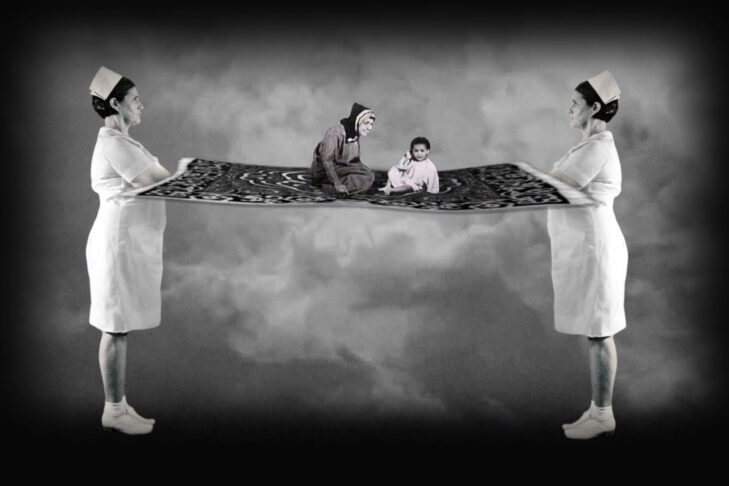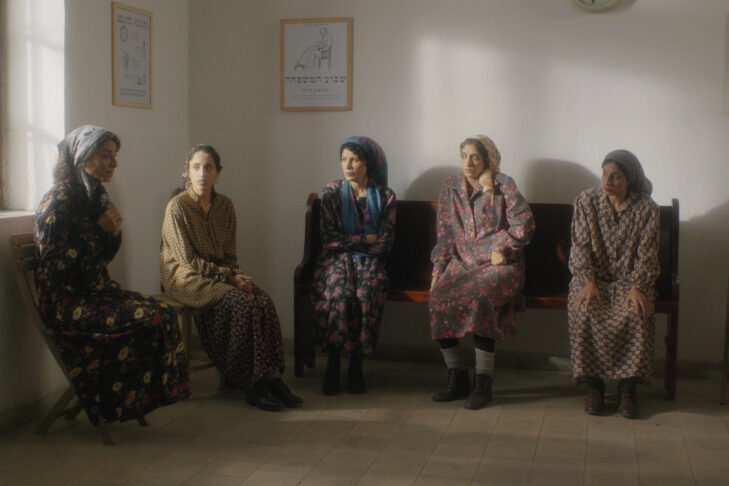It is known as the Yemenite Children Affair and occurred during a fraught time in the new State of Israel when Yemenite babies and toddlers went missing. There were over 1,000 official cases opened, but some in Israel’s Mizrahi community believe the number of children who disappeared is closer to 4,500. The families believe their children were abducted and illegally adopted in the early 1950s by Ashkenazi couples, some of whom were Holocaust survivors.
While a vocal group in Israel dismissed the affair as a conspiracy theory, it garnered attention again in 2016 when the government released over 400,000 classified documents from the state archives. Among the available documents were the children’s files, which included hospital records and burial certificates. For Israeli mixed-media artist Tamar Nissim, access to the archives not only expanded her ongoing research into the history of the early years of Israel’s establishment but dovetailed with her propensity to use archives in her art. Additionally, Nissim consulted the Hadassah Archives in New York, the Central Zionist Archives in Jerusalem and the National Library of Israel for photographs and information.
Related
Multiple visits to various archives informed Nissim’s project, “Contagious Truths,” which showcases dangerous silences in history, the ethnic fault lines that appeared in Israel and the medical establishment’s abuse of power in the state’s early years. On view at the Hadassah-Brandeis Institute’s Kniznick Gallery through July 8, 2022, Nissim’s mixed-media exhibit presents the brutal conditions—both physical and emotional—with which Yemenite mothers had to contend. Her short videos show the inhospitable and hostile environments these women had to endure. To emphasize the role that hygiene played in the debacle, she includes stark photographs of cleaning products and objects, including glass bottles and bars of olive oil soap. Nissim does all this in service to the ways western hygiene used racist tropes to control women’s bodies—particularly those of Mizrahi women—in mid-century Israel.
During her research, Nissim said she realized “the extent of the medical establishment’s abuse of these Yemenite women. I thought about the nurses involved in this cover-up who were brainwashed to think that these [Yemenite] mothers were not capable of raising their children. I was shocked these nurses were an important factor in the abuse. I was also shocked when I understood that this was happening just three years after the Holocaust ended. Using hygiene this way reminded me of what happened in Europe when medical institutions took on the vocabulary of the abuser.”
Nissim pointed out the new immigrants from Yemen came to Israel feeling as if they were living through a second Exodus. “They traveled to Israel any way they could,” Nissim said. This meant that the immigrants were woefully unprepared for trekking through mountainous terrain and coping with exposure to harsh weather to reach the transit camp in Aden. She said the camp was built to house 10,000 refugees in tents but eventually warehoused 200,000 people. “The Yemenites came to Israel very ill and in the middle of an unusually harsh winter,” she explained. “Almost immediately, the new emigres were looked down for their old-world ways. People thought they were dirty or unhygienic, and the medical establishment contributed to this myth. Hygiene was a way to make a newer, stronger generation of Israelis. Health was about being clean.”
It was a tense time for the new state, which was involved in multiple skirmishes at its borders and facing the severe economic strain of mass immigration. However, Nissim said nothing excuses the willful kidnapping of the Yemenite children. The children were often taken from the tents and placed in heated houses; mothers were told that their babies needed to recover or had died. However, much was lost in translation. “The mothers were completely lost when asked to breastfeed their babies,” she said. “Sometimes the mothers were ill or had difficulty reaching their children for two or three days. The nurses thought the babies had been abandoned. All of this happened in combination with cultural misunderstanding and racism.”
For the past three decades, the Israeli government has investigated the Yemenite Children Affair through various commissions. The subject resurfaced in full force after DNA testing became widely available. As a result, there have been cases of children believed to have died as infants who were reunited with their families of origin as adults. To be more transparent, the Israeli government has recently released the testimonies of nurses who worked at hospitals, corroborating that the babies were taken from their mothers.
Shortly after Nissim finished her work on “Contagious Truths,” COVID-19 infected the world. Amid the fear, chaos and death the virus unleashed, Nissim heard echoes of Israel’s initial efforts to cleanse society of cultural differences. “There was so much value judgment on societies not capable of keeping themselves clean,” she said. “Something as innocent as hygiene influenced people’s thoughts in prejudicial ways.”
Shortly before “Contagious Truths” opened, Nissim updated the exhibit with COVID-19 in mind. “I thought a lot about how something pure and good and healthy can turn into an unhealthy relationship within society,” she said. “About COVID hygiene, I heard the same slogans from 70 years ago. We still have the same attitudes toward minorities, immigrants and others. Fear manipulated thoughts. And what was happening with COVID had already happened during outbreaks of polio and typhoid.”
In 2018, the Israeli Parliament passed a law enabling families to request court-ordered exhumation of graves and access to adoption files. Nissim is hopeful that the conspiracy theories surrounding Yemenite children’s disappearances will die down to allow for the truth to emerge. However, said Nissim, “These theories persist as we saw with COVID-19. It’s not healthy for a society to support these conspiracies.”
“Contagious Truths” is on display at the Hadassah-Brandeis Institute’s Kniznick Gallery through July 8, 2022.









